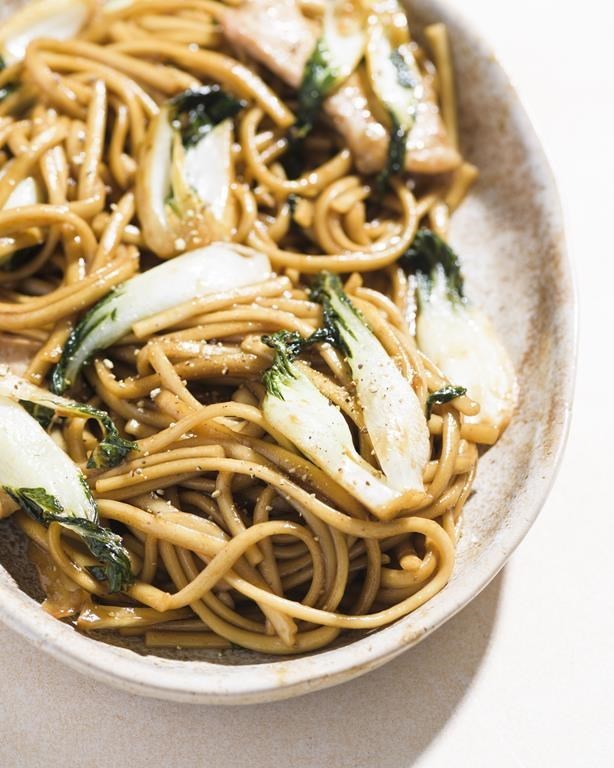Around the world people prepare special foods for the new year to symbolize luck or wealth, often drawing on traditions that date back centuries. In East Asia, for example, the shape of noodles represents a long life, while greens augur a prosperous year.
To kick off 2024 right, try both in this Shanghai-style stir-fry from our book “Noodles,” which adapts beloved noodle dishes worldwide for American home cooks. Typically, the noodles in this dish, called cu chao mian, are thick, chewy and wheaty, and they give the simply seasoned stir-fry much of its appeal. Japanese udon is similar in appearance and texture, and since it’s easier to find in dried form in supermarkets, it’s what we call for in our version of the dish.
For the greens, we like bok choy — its more tender leaves and crispier bases are like two vegetables in one. Make sure to wash and dry the bok choy before cooking to remove the grit that often collects between the leaves. First cut the bok choy lengthwise into quarters, then dunk the pieces in a bowl of water and swish around. Lift out the bok choy and pat dry with paper towels.
We round out the dish with slices of succulent pork loin, which is briefly marinated in soy sauce, Shaoxing wine (or dry sherry), sugar and cornstarch. But there is virtually no sauce to speak of in this stir-fry — the noodles absorb the flavorings and in doing so take on a brownish hue.
We admit to cheating a little by adding oyster sauce — not a typical ingredient in Shanghai fried noodles — as it brings some sweetness along with loads of umami. The balsamic vinegar may also seem like an odd ingredient, but it’s a great stand-in for malty, subtly sweet Chinese black vinegar that’s made from rice. The vinegar’s acidity nicely balances the deep, savory notes in the dish.
SHANGHAI-STYLE FRIED NOODLES
Start to finish: 40 minutes
Servings: 4
2 teaspoons plus ¼ cup soy sauce, divided
2 teaspoons Shaoxing wine or dry sherry
2 teaspoons white sugar
1 teaspoon cornstarch
6- to 8-ounce boneless pork loin chop, sliced crosswise in ⅛-inch slices
2 tablespoons oyster sauce
1 tablespoon balsamic vinegar or Chinese black vinegar
Ground white pepper
10 ounces dried udon noodles
2 teaspoons toasted sesame oil
2 tablespoons grapeseed or other neutral oil
8 ounces baby bok choy, trimmed and quartered lengthwise
In a medium bowl, whisk together the 2 teaspoons soy sauce, the wine (or sherry), sugar and cornstarch. Add the pork and toss to coat; set aside. In a small bowl, combine the remaining ¼ cup soy sauce, oyster sauce, vinegar and 1/2 teaspoon white pepper; set aside.
In a large pot, bring 4 quarts water to a boil. Add the noodles and cook, stirring occasionally, until just shy of tender. Drain in a colander and rinse under cold water, tossing well, until cool to the touch. Drain again, shaking the colander to remove as much water as possible. Drizzle with the sesame oil and toss to coat; set aside.
In a 12-inch skillet over medium-high, heat the neutral oil until shimmering. Add the pork in an even layer and cook, stirring occasionally, until lightly browned, 1 to 2 minutes. Using a slotted spoon, transfer the pork to a plate.
To the now-empty skillet, add the bok choy; cook, stirring often, until the leaves are wilted and the stems are translucent, about 2 minutes. Add the noodles and soy mixture. Cook, stirring often, until the noodles have absorbed most of the liquid, 3 to 4 minutes. Add the pork and any accumulated juices. Cook, tossing, until the noodles are dry, 1 to 2 minutes. Off heat, taste and season with white pepper.
EDITOR’S NOTE: For more recipes, go to Christopher Kimball’s Milk Street at
Christopher Kimball, The Associated Press




